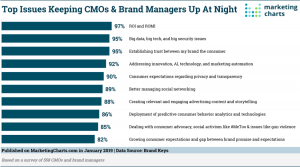According to eMarketer’s latest research report, total digital ads spending will surpass television ads for the first time in 2017. It estimates that companies will invest around $ 72 billion in TV ads (or 36% of total media budget) while online ads spending will be around $ 77.4 billion (or 38% of total media budget). It also projects very positive outlook for digital ads industry in 2016 as online ads spending will increase by 15.4%, totalling $ 68.82 billion by the year end. This report by a premier research agency indicates a steady growth for digital world as companies will invest more in digital media, ads and online marketing.
On the other side of the story, marketers who are assigned to do the job face another challenge of optimizing their performance. Roughly 24% of CEOs are happy with the performance of their CMO’s and one of the key reasons behind this low level of confidence is lower return on digital spending. Given this serious question on the performance, marketers need to optimize their performance by constantly updating skills set, reading latest researches, and learning from the industry trends and practices. In the following, we are also sharing some tips for marketing a business, product or service with special reference to digital world.
1. Adopt a Data-Driven Strategy:
In the last couple of years, we’ve seen enterprises consciously working on and embracing data-driven business strategies. It has been declared as one of the most important evolutionary step in the marketing history as you can understand the data you acquire, you can get the data you desire, and organize it to gain certain business objectives. This is exactly what will revolutionize the digital marketing in the days to come. Therefore, in order to drive a decent return on digital marketing investment, data-driven strategy is the first right step.
In 2016, monitoring digital media for information, analysis of channels’ performance, and managing content’s life cycle will work wonders. This requires data analysis and measurement tools that could provide you real-time updates as well as in-depth analysis of the industry/channel trends. In addition, you can go for your own market research. You can conduct market research with mobile surveys, marketing tools, social media channels email campaigns, or open surveys. The findings should help you make good customer personas and also devise a better content, ads, and social media program.
Now it’s up to you; how do you acquire data and what kind of information pieces you seek for the business decisions. You need to work on your data sources, data types, data pieces, data organization, and finally data interpretation for making the sound business decisions. But don’t forget to avoid paralysis by analysis.
2. Move from Quality Content to Engaging Content:
If you want summarize the modern SEO, it’s just developing quality and engaging content. Google will reward the maximum visibility to the articles, images and stories that are of optimal quality and receiving greater engagement. However, the focus shouldn’t be only on content quality; instead, (as I wrote in a previous post on business2community) brands need to migrate from quality content to engaging content. This post elaborates why you need to migrate from quality to engaging content and how to make a trendy and shareable piece today.
In short, engagement for blogs, images, videos and articles means; people read them, like them and share them to their network. While premium contents like e-books, e-guides, and PPTs engagement level is determined by number of downloads and link clicks.
There’s only one way of developing engaging content. Keep learning and refining your content as per the audience’s feedback. Moreover, don’t rely on organic reach; instead, optimize your audience reach by sponsoring your updates as well as disseminating it through multiple channels like; blogs, social media, email, podcasts, and website.
3. Utilize Visuals to Strengthen Storytelling:
Going by the Ascend2’s2015 Video Marketing Strategy Survey, enterprises are plan to double down on moving pictures in 2016. Whether you intend to develop videos and graphics for your website and blog or social media, they are essential marketing tool that can drive engagement and help in achievement of business goals. In fact, it’s all about effective storytelling and projecting your product/service’s value to the prospects using captivating communication channels. The popularity of infographics and feature images is a glowing example of visual’s importance.
Check few stats from a HubSpot’s study.
- 46% marketers agree that visuals are critical to their current marketing and storytelling strategies.
- Content with images receive 94% more views
- 73% of content creators plan to prioritise creating more engaging content in 2016, and 55% plan to prioritise creating visual content.
- 34% of marketers selected visual assets as their most important content, behind blogging (45%) and before videos (19%).
- 39% of marketers agree on allocating most of the budget to the acquisition or creation of compelling visual assets.
Since images and videos have their own search index in Google and YouTube, they can help in added visibility and business development. So work on visual storytelling, infographics, and unique video content. I would recommend having a dedicated set of visual assets, video channel, and infographics boards to serve different niches of the market and gain their attention.
4. Never Ignore Personalized Marketing:
Marketing success is heavily dependent on effective targeting and nothing could serve better than personalized marketing. The key to content’s success these days is to ensure it meets the preferences and needs of your targeted persona. In 2016, marketers need to ensure that these profiles and personas are right on target and this involves data and research. As noted in the first point, data-driven marketing and strategy are the key to goals achievement and better ROI. Customers love the personalized experience where product and service is tailored to their needs. This applies to the marketing content that we feed them via different channels. Something that highlights their pain points in empathic tone and suggests solutions in an authoritative manner.

5. Focus On Mobile:
If one has to pick up one factor that relates to all types of marketing, it’s mobile. Mobile has become the most important marketing factor that impacts web development, content creation, design, user experience, and promotion. Look at the following points to learn why mobile matters.
- Around 80% of internet users while 92% of Americans own a smartphone
- The projected number of smartphone users (by year end) is 2 billion
- Mobile ad spending in United States will grow by 38.0% this year; totalling a whooping amount of $ 43.60 billion.
- Mobile counts for 63.4% of total digital ad spending in USA
- Google’s mobile algorithm has made ‘mobile friendliness’ a key search ranking factor that
“In our experience, we’ve seen people focusing more on apps, features and functions that give them a sense of personalization. They look for something that’s tailored to their needs; be it app, content, or a mobile feature.” Says Chris S, CEO of XpressFix; a mobile maintenance and development company in Colorado.
Finally, modern marketing is all about delivering users what they want, in the way they way and in the form they like. As a digital marketing professional, your first duty is to understand your buyer’s journey and design touch points keeping all the listed factors in mind. Start with a killing strategy and go for effective execution to achieve your digital marketing goals in 2016.
Digital & Social Articles on Business 2 Community(65)









